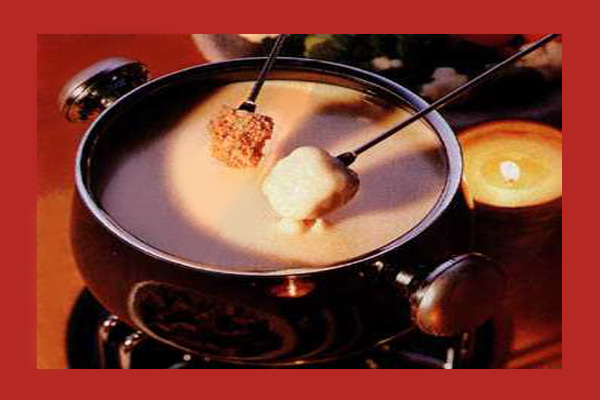Fondues
Welcome your guests with a hot fondue
Three Cheese Fondue
Ingredients:
1/2 lb Havarti (grated)
1/2 lb Gruyère (grated)
1/2 lb Emmenthal (grated)
1½ tablespoons cornstarch
2 garlic cloves, halved
1 cup dry white wine
1/2 cup water
2 teaspoons fresh lemon juice
3 tablespoons Calvados
1/4 cup tomato onion chutney
To Serve:
6 cups cooked tortellini
6 cups assorted cooked vegetables (carrots, broccoli, cauliflower, green beans, potatoes etc.)
6 cups fresh bread cubes
Directions:
1. Toss together cheese and the cornstarch in a large bowl, set aside.
2. Rub the fondue pot with garlic, leave garlic in the pot and add wine, water and lemon juice. Bring to boil. Reduce heat to medium.
3. Stir in cheese mixture 1 handful at a time, stirring constantly until cheese is melted.
4. Add Calvados and tomato onion chutney and simmer about 2 to 3 minutes, stirring constantly.
5. Set the fondue pot on fondue stand over low heat.
6. Serve with prepared cooked vegetables, cooked tortellini and fresh bread cubes.
Makes 6 servings.
Tips:
 For cheese fondue always use shallow, heavy bottomed cast-iron or porcelain fondue pot.
For cheese fondue always use shallow, heavy bottomed cast-iron or porcelain fondue pot.
 You should never fill more than 1/3 of the fondue pot with melted cheese, because it may bubble up when raw food is added.
You should never fill more than 1/3 of the fondue pot with melted cheese, because it may bubble up when raw food is added.
 Stir fondue from time to time to keep it combined.
Stir fondue from time to time to keep it combined.

RomWell Cookbook
Discover various delicious and useful recipes...Did You Know?
Civilization in its onward march has produced only three important non-alcoholic beverages—the extract of the tea plant, the extract of the cocoa bean, and the extract of the coffee bean.
Leaves and beans—these are the vegetable sources of the world's favorite non-alcoholic table-beverages. Of the two, the tea leaves lead in total amount consumed; the coffee beans are second; and the cocoa beans are a distant third, although advancing steadily. But in international commerce the coffee beans occupy a far more important position than either of the others, being imported into non-producing countries to twice the extent of the tea leaves. All three enjoy a world-wide consumption, although not to the same extent in every nation; but where either the coffee bean or the tea leaf has established itself in a given country, the other gets comparatively little attention, and usually has great difficulty in making any advance. The cocoa bean, on the other hand, has not risen to the position of popular favorite in any important consuming country, and so has not aroused the serious opposition of its two rivals.

